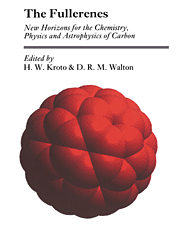Book contents
- Frontmatter
- Contents
- The evolution of the football structure for the C60 molecule: a retrospective
- Dreams in a charcoal fire: predictions about giant fullerenes and graphite nanotubes
- On the formation of the fullerenes
- Production and discovery of fullerites: new forms of crystalline carbon
- Systematics of fullerenes and related clusters
- The fullerenes: powerful carbon-based electron acceptors
- The carbon-bearing material in the outflows from luminous carbon-rich stars
- Elemental carbon as interstellar dust
- The pattern of additions to fullerenes
- Pollyynes and the formation of fullerenes
- Hypothetical graphite structures with negative gaussian curvature
- Fullerenes as an example of basic research in industry
- Deltahedral views of fullerene polymorphism
- Geodesic domes and fullerenes
Elemental carbon as interstellar dust
Published online by Cambridge University Press: 03 February 2010
- Frontmatter
- Contents
- The evolution of the football structure for the C60 molecule: a retrospective
- Dreams in a charcoal fire: predictions about giant fullerenes and graphite nanotubes
- On the formation of the fullerenes
- Production and discovery of fullerites: new forms of crystalline carbon
- Systematics of fullerenes and related clusters
- The fullerenes: powerful carbon-based electron acceptors
- The carbon-bearing material in the outflows from luminous carbon-rich stars
- Elemental carbon as interstellar dust
- The pattern of additions to fullerenes
- Pollyynes and the formation of fullerenes
- Hypothetical graphite structures with negative gaussian curvature
- Fullerenes as an example of basic research in industry
- Deltahedral views of fullerene polymorphism
- Geodesic domes and fullerenes
Summary
C60 has not yet been detected in primitive meteorites, a finding that could demonstrate its existence in the early solar nebular or as a component of presolar dust. However, other allotropes of carbon, diamond and graphite, have been isolated from numerous chondritic samples. Studies of the isotopic composition and trace element content and these forms of carbon suggest that they condensed in circumstellar environments. Diamond may also have been produced in the early solar nebula and meteorite parent bodies by both low-temperature-low–pressure processes and shock events. Evidence for the occurrence of another carbon allotrope, with sp hybridized bonding, commonly known as carbyne, is presented.
Introduction
At the same time that buckminsterfullerene was being conceived as a molecule of possible astrophysical significance, a number of much older forms of carbon were about to enjoy a new lease of life because of their discovery as presolar grains in primitive meteorites. Ever since the 1960s, it has been recognized that carbonaceous chondrites were a host for noble gases of anomalous isotopic composition (Anders 1981). The carriers of a litany of components, enjoying names such as Xe(HL) (also called CCF-Xe), s-Xe, Ne-E(L), Ne-E(H), etc., were believed to be unidentified carbon species called C∂, Cβ, Cα and C∈ respectively, themselves exhibiting unusual or exotic isotopic compositions (Swart et al. 1983a; Carr et al. 1983). In 1987, C∂ was shown to be diamond (Lewis et al. 1987) the meteorite mineral which contained Xe(HL) and nitrogen whose isotopic composition was greatly enriched in the light isotope 14N (Lewis et al. 1983).
- Type
- Chapter
- Information
- The FullerenesNew Horizons for the Chemistry, Physics and Astrophysics of Carbon, pp. 73 - 86Publisher: Cambridge University PressPrint publication year: 1993



